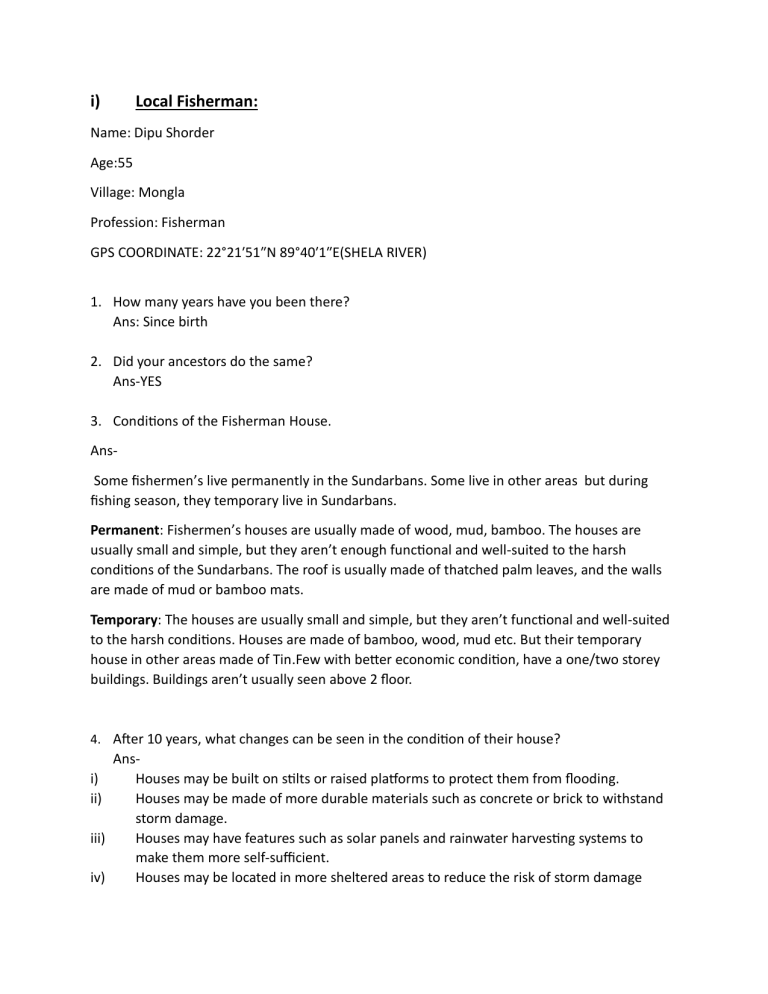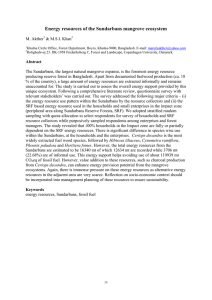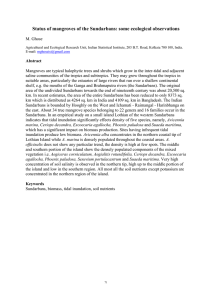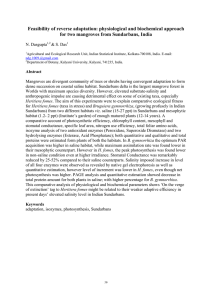Sundarbans Urbanization: Interview Transcripts & Impact Analysis
advertisement

i) Local Fisherman: Name: Dipu Shorder Age:55 Village: Mongla Profession: Fisherman GPS COORDINATE: 22°21′51″N 89°40′1″E(SHELA RIVER) 1. How many years have you been there? Ans: Since birth 2. Did your ancestors do the same? Ans-YES 3. Conditions of the Fisherman House. AnsSome fishermen’s live permanently in the Sundarbans. Some live in other areas but during fishing season, they temporary live in Sundarbans. Permanent: Fishermen’s houses are usually made of wood, mud, bamboo. The houses are usually small and simple, but they aren’t enough functional and well-suited to the harsh conditions of the Sundarbans. The roof is usually made of thatched palm leaves, and the walls are made of mud or bamboo mats. Temporary: The houses are usually small and simple, but they aren’t functional and well-suited to the harsh conditions. Houses are made of bamboo, wood, mud etc. But their temporary house in other areas made of Tin.Few with better economic condition, have a one/two storey buildings. Buildings aren’t usually seen above 2 floor. 4. After 10 years, what changes can be seen in the condition of their house? i) ii) iii) iv) AnsHouses may be built on stilts or raised platforms to protect them from flooding. Houses may be made of more durable materials such as concrete or brick to withstand storm damage. Houses may have features such as solar panels and rainwater harvesting systems to make them more self-sufficient. Houses may be located in more sheltered areas to reduce the risk of storm damage 5. Were these Schools and Colleges 10 years ago? Ans- No 6. Present Condition of School and Colleges in Sundarbans. Ans: In Sundarban barely have seen primary school. Most of the boys are engaged in fishing with their father as they grow up. During the off season of fishing they do some study. Girls are usually given in early marriage or they are also engaged in fish processing. Many parents send their children to other places for education. In there children continues their study from hostels. 7. Have there any shelter facilities to deal with natural calamities? Ans-YES 8. Are that shelter enough sufficient to protect all people? Ans: No 9. Is there a clinic- hospital nearby? Ans-No 10. How people get services from hospitals? Ans: The Sundarbans have various healthcare options for their residents, depending on their location and condition. Government hospitals are mostly in larger towns and villages, while private hospitals can be expensive. Four mobile boat clinics provide free primary healthcare services to remote areas once a week. Water ambulances are also available, but can be expensive and not always available. 11. How do they arrange drinking water? Ans- Re-excavating ponds, establishing solar-based pond sand filter system as well as reverse osmosis system with water ATM and installing wells. 12. Any govt./ non-govt. supports for drinking water? Ans-Yes, Such as-Bangladesh Environment and Development Society (BEDS) 13. Is there any waste management system in tourist spots/tourist ship? (Karamjal, Kotka, Jamtoli sea beach)? Ans- Yes. The Sundarbans have waste management systems in tourist spots and ships, but their effectiveness varies. Strategic waste bins and staff are in place, but inadequate infrastructure has led to litter and waste dumped in inappropriate locations. Some ships have improperly sorted and stored waste, posing environmental hazards. 14. Have there any security systems (security or forest guard)? Ans-Yes 15. Do they throw their domestic waste directly into the river? Ans-Yes 16. Are the number of fishermen decreasing/increasing due to urbanization? Ans: Decreasing. Major Causes- Scarcity of fish availability, Illegal fishing, Pirate attacks. ii) Other Profession: Name: Mohi Age:52 Location: Bagerhat Profession: Guard(In Koromjol) GPS COORDINATE: 22.4285° N, 89.5917° E(KOROMJOL) 1. How many years have you been there? Ans: Since birth 3.Are the breeding of crocodiles decreasing in Koromjol due to urbanization? Ans: Yes. Habitat loss, overfishing and population affect the breeding of crocodiles. 4. What is your opinion on increase/decrease in value of land purchase and sell? Ans: Land’s prices are increasing in Sundarbans due to establish tourist spot and urbanization. Land purchase and sell are decreasing due to high price ,environmental concerns ,economic factors and social factors. 5. Are you support the urbanization in Sundarbans? Ans: Yes 6.What changes are you want to see in Sundarbans? Ans: Proper maintenance of tourists and tourist spots, Waste management, Availability of resources mainly fish. iii) Second-time Visitor tourist Name: Monirujjaman Momin Age:23 Location :Dhaka Profession :Student and Researcher GPS COORDINATE: 22°21′51″N 89°40′1″E (SHELA RIVER) 1. Did you see any difference before and after in Sundarbans? Ans-No, not so much. 2. What place have you visited before? Ans- Joymonik (most of the fishermen’s live here) 3. Are there any variations Tourist in seasonally? Ans-Yes 4. Any shelter facilities for tourists to deal with natural calamities. Ans- Yes 5. Have you seen the help of govt./non-govt. organizations for serving food and cloth during natural disasters? Ans-Yes iv) New tourist: Name: Hafiz Uddin Age:28 Location: Bogura Profession: Student GPS COORDINATOR: 22.4285° N, 89.5917° E (KOROMJOL) 1. Where did you go? Ans- Jamtola beach, Koromjol, Andharmanik Ecotourism 2. What opportunities did you see? Ans- Forest guard camp, ship availability, ecotourism environment management. 3. What is your opinion on the ship facility? Ans-Good 4. What is your opinion on dumping waste into the river? Ans- From the ship management people ,I came to know that they have a management in ship for storing dumpings. They don’t dump waste into the river. After finishing the trip, they dump storing waste in a exact location. 5. In future, are you want to see more tourist spot in Sundarbans ? Ans: Yes 6.What is your opinion on animal welfare? Ans: A responsible tour operator ,Respect the wildlife ,legal action and report any poaching/other illegal activities to the authorities can solve the problem of animal poaching and habitat loss in Sundarbans Overall urbanization Impact on sundarban: Urbanization has brought both opportunities and challenges to the Sundarbans, a globally significant region straddling India and Bangladesh. The growth of urban centers in proximity to this fragile ecosystem has led to a range of impacts. On the positive side, urbanization has driven economic development, generating employment and income opportunities for local communities. Infrastructure in the region has improved, providing better access to healthcare, education, and other essential services. Urban areas also serve as educational hubs, promoting awareness about environmental conservation and sustainable development in the Sundarbans. However, the negative impacts are substantial. Urban expansion has resulted in habitat loss, with mangrove forests, vital for various species, being cleared for urban and industrial development. Pollution, particularly water pollution from industrial and domestic sources, threatens the delicate balance of the Sundarbans' ecosystems. The encroachment of urban areas into wildlife habitats has led to increased human-wildlife conflicts, particularly with species like tigers and crocodiles. Moreover, urbanization contributes to increased carbon emissions, exacerbating climate change and subjecting the low-lying Sundarbans to the perils of sea-level rise and extreme weather events. The heightened demand for natural resources in urban areas further strains the Sundarbans' already fragile ecosystem. In addition, the growth of urban areas can displace indigenous and local communities, impacting their traditional ways of life and cultural heritage. Addressing these issues necessitates sustainable urban planning, stringent environmental regulations, conservation initiatives, and active community involvement to strike a balance between economic development and environmental preservation in the Sundarbans.






